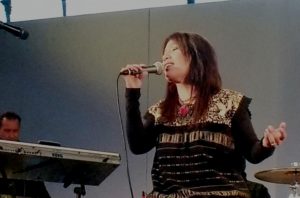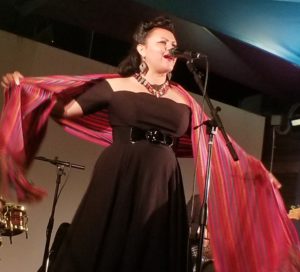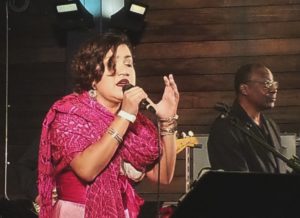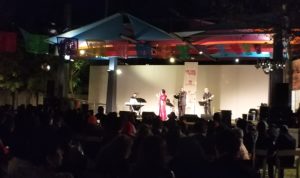Three powerful women bring boleros to a sparkling LA night.
by Patrick O’Heffernan
(Los Angeles) When asked about the “pure bolero”, Martha Gonzalez, one of the singers at the female-led 4th Annual Boleros de Noche concert last Friday night and an Assistant Professor of Chicana/o Latina/o Studies at Scripps College, replied, “I would venture to say that there never was a pure Bolero – it has always been in transition…it responds to humanity and our plight and our visions of what love is, or isn’t or was”.
 Whether or not there ever was a pure Bolero, at its core the form is beautiful music about love. That beauty shimmered and sailed through downtown Los Angeles Friday night as three Los Angeles-based boleritas – Martha Gonzales, Rocio Mendoza of Tres Souls, and Margarita Luna — took over the stage at La Plaza for The 4th Annual Boleros de Noche. The three and half hour program of music and conversation kept the capacity audience on the 30,000 square-feet of gardens, lawn and outdoor stage happy and singing to last joyful note despite the chilly night and hard wooden chairs.
Whether or not there ever was a pure Bolero, at its core the form is beautiful music about love. That beauty shimmered and sailed through downtown Los Angeles Friday night as three Los Angeles-based boleritas – Martha Gonzales, Rocio Mendoza of Tres Souls, and Margarita Luna — took over the stage at La Plaza for The 4th Annual Boleros de Noche. The three and half hour program of music and conversation kept the capacity audience on the 30,000 square-feet of gardens, lawn and outdoor stage happy and singing to last joyful note despite the chilly night and hard wooden chairs.
When asked about changes she has seen in local audiences in her 20 years of singing Boleros, Margarita Luna, the bolerista who opened the show said, “people were more relaxed in the past…now it takes longer for me to put them in the mood to be relaxed”. That did seem to be true as people filed in through La Plaza’s metal art sculptured gates and hurried to get food and drink and a spot on one of the wooden or plastic chairs. But as soon as Emcee Eddie Padilla took the microphone, you could feel the thoughts of traffic and parking and finding friends and food begin to melt away. By the time Luna flashed her 1000-watt smile from the stage, chatted a bit in Spanish, and then filled the space with her first bolero, the audience was fully relaxed.
She sang a highly energetic Bolero in Spanish, accompanied by a piano, fast-moving violin, and Latin percussion. After comments in English, she slowed the tempo for a classic bolero with a gentle rhythm and plenty of opportunity for her wide-ranging voice to sail out of the band shell to the street. She moved back to Spanish and the Latin beats, her body swaying to the congas and cáhon while her lyrics intertwined with the violin before picking up the guitar, sitting down and caressing the audience with a soft, crooning Bolero that broke hearts in any language. But for her final song she couldn’t contain herself – the Cuban rhythms came out full force in a Bolero that was both romantic and sexy, and very danceable.

After the stage was reset, and the audience had time to refill at the bars and refuel at the cocinas, Emcee Eddie Padilla introduced Tres Souls, a beloved institution in the LA Latino music and Bolero community. Their self-titled album, released appropriately on Valentine’s Day, provided many of their songs that filled the La Plaza, with Rocio Mendoza’s powerful voice intertwining with stunning flamenco-style guitar picking by Jesús Martinez and moved along rhythmically by maracas and Roberto Carlos guitar strum. The band is leading a revival of “Trio Romántico,” music, the vintage sounds and songs of the 1940s -1960s Bolero style that was popular during the ‘Golden Era of Mexican Cinema” But it is not all nostalgia; guitarist Roberto Carlos points out that their Boleros Made In LA that “ we preserve classical sound but I have added electric guitars and reverbs, big, big reverbs…fusion is a beautiful thing”. A quick look at their album validates that; along with classic sounds like “Mi Amor” and “La Luna Eres Tu”, there is a joyful Bolero of the 1965 Temptations song “My Girl”.
When Emcee Padilla introduced Martha Gonzalez, you could tell virtually everyone in the audience knew and loved her. It took a few moments for folks to settle down from the clapping and cheering when Gonzales came on stage with an all-star band: Alberto Salas on piano, Joey De Leon on percussion, the amazing Artie Webb on flute, and Dante Pascuzzo on bass. She was later joined by her brother, the singer Gabriel Gonzalez, and her young son, Sandino Gonzalez-Flores, who played the flute and joined her on vocals. She set the stage for magic, and she delivered.

“I think that together we are transported to this moment of love and heartache and anger and rejoicing”, Gonzales muses about the effect of Boleros on an audience. That was clear from the audience response to Luna and Tres Souls; they knew many of the songs and got lost in them. “The Bolero is very a generous genre to the singer – I am not doing much, I am interpreting, but then everyone knows the song”, Gonzales says, explaining the love that floats back and forth from stage to audience in Bolero. She says one reason for this is that “Bolero is one of the few genres where men can be really sensitive and poetic” – accounting for the many unembarrassed tenors in the audience.
Gonzalez treated the audience to a full set of eight classic-style Boleros. With slow, sensuous Latin rhythms on the congas and percussion, bright accent melodies on Artie Webb’s luminescent flute, she fashioned heart-wrenching musical tales with a voice so powerful that every nuance reached the back rows. Her son Sandino joined her for three songs, at one point slow dancing with his mother while he sang and in another song, accompanying Webb on the flute. Her bother Gabriel joined her in a classic duet while Sandino played the flute with the band. Family magic at its best, under the stars and twinkling lights in an island of music and love in the center of downtown Los Angeles. Gonzalez may be right that there never was a pure Bolero, but Boleros de Noche was a night of pure pleasure.
Patrick O’Heffernan. Host, Music FridayLive!,
Video: Margarita Luna – Boleros de Noche, Los Angeles
Video: Martha Gonzales – Boleros de Noche, Los Angeles
